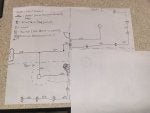Most of my questions I've figured out, even how to properly wire up a 5-way circuit with 3 fixtures ( ) but I have found limited information on this question so I thought I'd ask you lovely folks 🥰
) but I have found limited information on this question so I thought I'd ask you lovely folks 🥰
If I'm understanding it right, I can run romex from the breaker to an electrical box, put in a pig tail for the rooms light circuit (prior to the switch), then just continue on to the next room's light circuit? Like I understand the flow, but I'm curious about the code and such, I plan to stay under 10 lights/outlets per 20A circuit/main.
If I'm understanding it right, I can run romex from the breaker to an electrical box, put in a pig tail for the rooms light circuit (prior to the switch), then just continue on to the next room's light circuit? Like I understand the flow, but I'm curious about the code and such, I plan to stay under 10 lights/outlets per 20A circuit/main.






